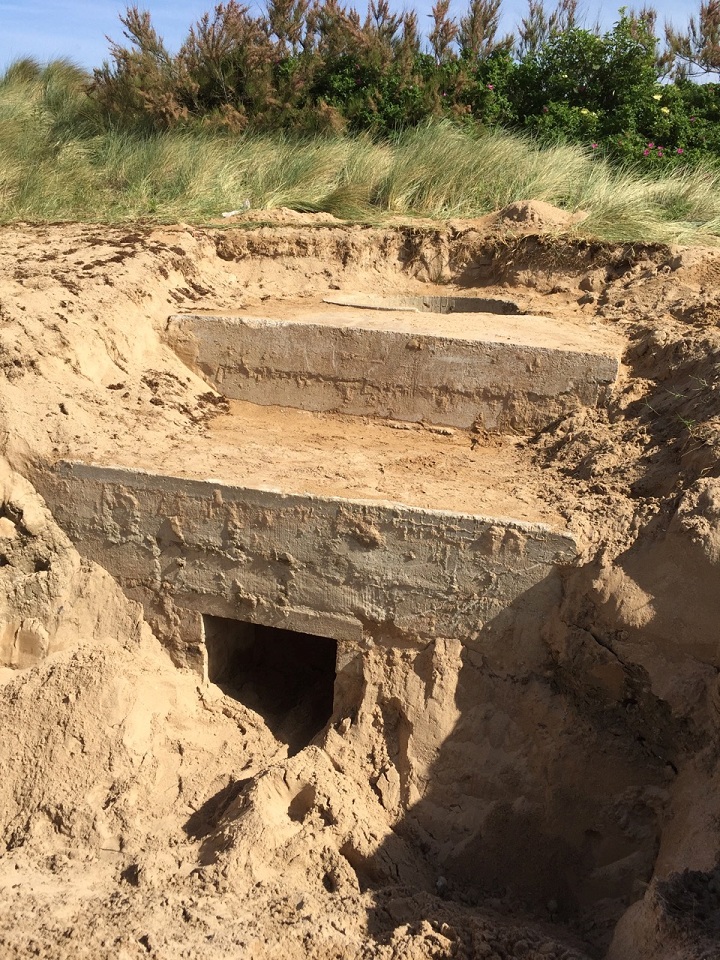Jim Parks was among the first Canadian soldiers to arrive on Juno Beach 71 years ago Saturday. He was a part of the unit meant to arrive moments before the D-Day assault began, to set up mortars while armoured bulldozers pulled out obstacles so assault craft could storm ashore.

Parks and the other members of the Royal Winnipeg Rifles had to swim through rough waters and strong current to get to the beach, while German machine gunfire whizzed towards them.
“But I wasn’t paying attention to them as much as surviving,” he recounted.
READ MORE: ‘War Junk’ crew uncovers lost German bunker on Juno Beach ahead of D-Day anniversary
As he came ashore, he and a “buddy” had to help pull their wounded fellow soldiers from the water — men just “seconds or minutes” ahead of Parks who got hit in the rain of bullets.
He “flopped down” beside a corporal who died of his wounds. Parks grabbed the corporal’s weaponry and took off towards the sand dunes. “Because there was another pillbox nearby.”
- Trudeau tight-lipped on potential U.S. TikTok ban as key bill passes
- Canadian man dies during Texas Ironman event. His widow wants answers as to why
- Hundreds mourn 16-year-old Halifax homicide victim: ‘The youth are feeling it’
- On the ‘frontline’: Toronto-area residents hiring security firms to fight auto theft
The “pillbox” he spoke of was a German machine gun position known as a Tobruk.
Tobruks were the concrete bunkers inside of which German gunmen stored their ammunition and took shelter from the Allied troops. On top of the Tobruks sat a turret, deep enough to provide shelter from gunfire while giving a 360-degree vantage point.
There were two Tobruks on Juno beach. They were a part of a network of German fortifications that stretched from France to Denmark.
While other remnants of D-Day remain visible on the beaches of Normandy, the two Tobruks on this stretch of Juno beach vanished over time. Their exact whereabouts, or whether or not they had been destroyed, remained a mystery until a Canadian documentary crew uncovered the lost relic last week.
The team behind History‘s War Junk travelled to northwestern France in search of the bunkers.
After a few days of aerial searches using archive photos and ground penetrating radar, War Junk‘s Wayne Abbott and David O’Keefe resorted to more traditional means.
With a couple plunges of a shovel into a sand dune, they hit their historic treasure.
“The first try, we hit Ground Zero,” said O’Keefe, a military historian at Montreal’s Marianopolis College, in footage provided to Global News.
After the initial prodding with the shovel, they brought in an excavator to dig down around the bunker, eventually deep enough to see inside the sand-covered and sand-filled structure.
While War Junk has in the past reunited families of veterans with mementos from their loved ones’ wartime past, Parks was unaware of what O’Keefe and Abbott found at Juno Beach last week.
“Looks like it could be… What do you call it? A machine gun nest,” he said to O’Keefe and Abbott at his Mount Albert, Ont. home on Thursday, adding a little bit of insight into what else could lie beneath the sands of Juno Beach. “There’s a lot of stuff that’s been buried there. There’s about five casements along there.”
“It’s a completely different view,” he said of the video footage O’Keefe and Abbott brought back from Juno Beach.
While Parks’ has dramatically clear memories of D-Day, he said the discovery of the Tobruk will help others better understand the history of what happened on June 6, 1944.
The discovery is a huge deal for the Juno Beach Centre, just a short distance away from where the Tobruk was swallowed up by the sand over the decades since the end of the Second World War.
While the centre’s volunteers will take over the excavation of the Tobruk, Worthington is hoping she can search out the support and funding that will be needed to preserve the structure and share it with the public.
Veterans Affairs Minister Erin O’Toole told Global News he’d “love to see a proposal with respect to this fortification” and his department will “hopefully” be able assist.
He applauded the Juno Beach Centre for preserving and presenting the history of D-Day and he hopes they can “incorporate this into their living history” when people go to learn about and pay tribute to what Canadian troops did.
READ MORE: Ex-crewmember recognizes photos of sunken Japanese WWII battleship
More than 350 Canadian soldiers lost their lives that day and more than 5,000 died during the Battle of Normandy. Canada sustained the highest number of casualties “of any division in the British Army Group.”
Parks has been back to Juno Beach to relive and recount his story four times, for the 40th, 50th, 60th and 70th anniversaries of D-D-Day.
He hopes to tell his story again, with the help of the uncovered Tobruk, when the 80th anniversary rolls around in nine years time.
In the meantime, O’Keefe, Abbott and the War Junk team will produce the story of their find as part of a four-part documentary series on the find for Remembrance Week on History in November. War Junk has offered an initial $5,000 to the Juno Beach Centre to start the excavation process.
History is a property of Shaw Media, the parent company of Global News.
With files from History and Global News reporter Mike Armstrong
Follow @nick_logan Follow @ArmstrongGN



Comments